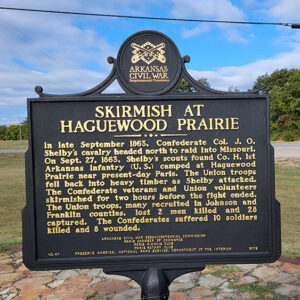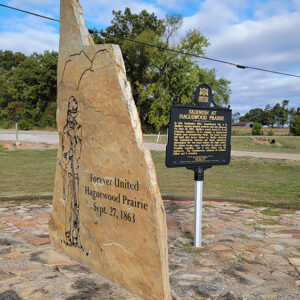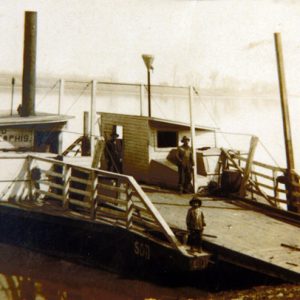calsfoundation@cals.org
Skirmish at Haguewood Prairie
| Location: | Logan County |
| Date: | September 27, 1863 |
| Campaign: | Shelby’s Raid into Missouri |
| Principal Commanders: | Captain William C. Parker (US); Colonel Joseph Shelby, Captain “Tuck” Thorpe (CS) |
| Forces Engaged: | Company H, First Arkansas Infantry (US); Shelby’s Brigade (CS) |
| Estimated Casualties: | 28 captured, 2 killed (US); 10 killed, 8 wounded (CS) |
| Result: | Confederate victory |
By late September 1863, Little Rock (Pulaski County) had just fallen to Union forces, and Arkansas Confederate forces were in disarray. Surrendering the state capital with little more than token resistance, the Rebel forces moved the seat of government to Washington (Hempstead County), leaving Union forces in control of most of the state north of the Arkansas River. Colonel Joseph Shelby proposed a raid into his native state of Missouri. His commanding general, John Marmaduke, saw little chance of success but backed Shelby nevertheless, hoping that the diversion would slow Union general Frederick Steele’s further advance, as well as rally the discouraged Southern sympathizers. On September 22, 1863, Shelby and 600 troops filed through Arkadelphia (Clark County) past Missouri Confederate governor Thomas Reynolds, General Sterling Price, and other officials. He was joined by additional forces as he moved northward.
More than 30,000 Union forces were stationed in Arkansas along the Arkansas River and to the north. Along with his cavalry, Shelby had twelve ammunition wagons and two pieces of artillery, which restricted where and how he could travel. Federal troops were known to be stationed at Dardanelle (Yell County), Clarksville (Johnson County), and Fort Smith (Sebastian County). Shelby directed his troops toward Roseville (Franklin County), a thriving farm community located on the Arkansas River with an excellent river crossing, port, and shallow ferry. With the exception of a skirmish with a large group of bushwhackers near Caddo Gap (Montgomery County), the Confederates met little resistance on the 150-mile leg of the journey until, at noon on September 27, 1863, advance scouts under Captain “Tuck” Thorpe encountered the First Arkansas Federal Infantry, who were camped at Haguewood Prairie.
The First Arkansas Infantry, Company H, was a newly organized group of troops composed of many volunteers from Franklin and Johnson counties. A. W. Bishop, adjutant general of Arkansas, reported that this group, commanded by Captain William C. Parker, had traveled to Dardanelle and received ammunition and other supplies that were to be distributed to local Union sympathizers (often dubbed “Mountain Feds”). Captain Parker accomplished his task and was returning by way of the Old Military Road, which runs from Dardanelle to Fort Smith. He camped at Haguewood Prairie, near present-day Paris (Logan County), to allow his men, who had been recruited from the area, to visit their families while the remainder of his troops rested in camp.
Both Union and Confederate groups were surprised at the encounter that resulted. Thorpe had been instructed by Col. Shelby to attack any group that he encountered, and, upon hearing the gunfire, Shelby would rush all troops to his support. The Union troops quickly realized that they were outnumbered and fell back into heavy timber. Shelby dismounted his troops, and a two-hour skirmish ensued. Some of the Federal troops had family members with them. The Fort Smith newspaper, The New Era, reported on September 30, 1863, that Private Benjamin Wilkins “fell pierced with several bullets, bravely discharging his six-shooter and killing one of his assailants.” Private William Hawkins was in one of the wagons, accompanied by his sister, and continued to fire until he was killed.
Some of the First Infantry, including Capt. Parker, escaped, but twenty-eight men were captured. Along with those captured were several individuals who were either visiting family or traveling with friendly Union forces to safety in Fort Smith. Shelby’s adjutant reported that one of the wounded men had three small daughters who cried pitifully, thinking their father was about to die. The Confederate troops, including Shelby, gave the mother gold coins to ensure that the family would be taken care of. Undoubtedly, this was the family of Private. Isaac Plumley, who survived and was discharged for wounds received. All but five of those captured were paroled immediately; the others were exchanged within days.
Shelby crossed the Arkansas River near Roseville later that night, rode through Ozark (Franklin County) early the next morning, and proceeded through the Boston Mountains and into Missouri in the following days.
For additional information:
“The Civil War in Logan County.” Wagon Wheels 1 (Summer 1981): 18–38.
Edwards, John Newman. Shelby and His Men, or The War in the West. Waverly, MO: General Joseph Shelby Memorial Fund, 1993.
Scott, Mark. The Fifth Season: General “Jo” Shelby and the Great Raid of 1863. Independence, MO: Two Trails Publishing, 2001.
The War of the Rebellion: A Compilation of the Official Records of the Union and Confederate Armies. Series 1, Vol. 22, Parts 1 and 2. Washington DC: Government Printing Office, 1888.
Young, Bennet H. Confederate Wizards of the Saddle. Nashville, TN: J. S. Sanders and Company, 1914.
Curtis Varnell
University of the Ozarks
 Civil War Timeline
Civil War Timeline Military
Military ACWSC Logo
ACWSC Logo  Haguewood Marker
Haguewood Marker  Haguewood Monument
Haguewood Monument  Roseville Ferry
Roseville Ferry 




Comments
No comments on this entry yet.